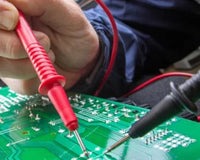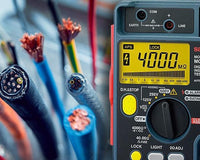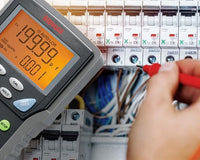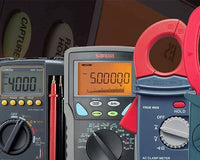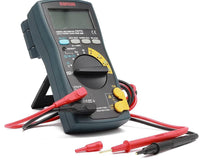Understanding the Distinction Between an Insulation Tester and a Megohmmeter
Also see: What is a High Voltage Digital Insulation Tester?
In electrical testing and maintenance, insulation testers and megohmmeters are two commonly used instruments that play a crucial role in assessing the insulation quality of electrical systems. However, despite their similarities, these two devices have distinct features and purposes. In this article, we will delve into the key differences between an insulation tester and a megohmmeter.
Insulation testers and megohmmeters are both used to measure the resistance of insulation materials, but they operate in different ways and are designed for different applications. Here are some key points of differentiation between the two:
- Principle of Operation
An insulation tester, also known as a "dielectric strength tester" or "hipot tester," works by applying a high voltage (typically 500V to 10kV) to the insulation material being tested and measuring the current that flows through it. It assesses the integrity of the insulation by measuring the resistance to the flow of current. On the other hand, a megohmmeter, also known as an "insulation resistance tester," applies a DC voltage (typically 100V to 1000V) to the insulation material and measures the resistance by detecting the leakage current that flows through it. - Measurement Range
Insulation testers are designed to measure high insulation resistance values, typically in the range of mega-ohms to giga-ohms, and are commonly used for testing high-voltage equipment, such as transformers, motors, generators, and cables. In contrast, megohmmeters are used for measuring lower insulation resistance values, typically in the range of kilo-ohms to giga-ohms, and are suitable for testing low-voltage equipment, such as control panels, switches, and wiring. -
Test Voltage
Insulation testers are capable of applying a much higher test voltage compared to megohmmeters. The high voltage applied by insulation testers allows for detecting weak points in the insulation and identifying potential breakdowns in high-voltage systems. Megohmmeters, on the other hand, use a lower test voltage that is safer for testing low-voltage systems. -
Test Time
Insulation testers typically require a longer test time due to the higher test voltage applied and the need to assess the integrity of insulation under high-stress conditions. Megohmmeters, on the other hand, require shorter test times as they operate at lower voltages and are suitable for quicker insulation resistance measurements. -
Display and Features
Insulation testers often come with advanced features, such as data logging, memory storage, and graphical displays, which provide comprehensive information about the insulation performance of the tested equipment. Some insulation testers also have built-in safety features, such as auto discharge of residual voltage after the test, to ensure operator safety. Megohmmeters, on the other hand, typically have simpler displays and features, focusing on basic insulation resistance measurements.
Let's compare the features of the Sanwa MG500, MG1000, and MG5000 Digital Insulation Testers:
Sanwa MG500 Insulation Tester- Test Voltage Range: 250V to 1000V
- Measurement Range: 0.01MΩ to 4000MΩ
- Test Current: 1mA at 250V, 500V, and 1000V
- Features: Large backlit LCD display, auto-ranging, data hold function, auto power-off, low battery indicator, built-in memory for up to 99 data sets, CAT III 600V safety rating.
- Test Voltage Range: 250V to 1000V / 500V to 1000V / 500V to 2500V / 1000V to 5000V
- Measurement Range: 0.01MΩ to 4000MΩ (250V to 1000V), 0.1MΩ to 4000MΩ (500V to 1000V / 500V to 2500V), 1MΩ to 4000MΩ (1000V to 5000V)
- Test Current: 1mA at 250V, 500V, and 1000V; 0.5mA at 2500V; 0.1mA at 5000V
- Features: Large backlit LCD display, auto-ranging, data hold function, auto power-off, low battery indicator, built-in memory for up to 99 data sets, USB communication, AC/DC voltage measurement, PI (polarization index) and DAR (dielectric absorption ratio) measurement, CAT IV 600V safety rating.
- Test Voltage Range: 50V to 1000V / 50V to 2500V / 50V to 5000V / 50V to 10,000V
- Measurement Range: 0.001MΩ to 40GΩ (50V to 1000V), 0.01MΩ to 40GΩ (50V to 2500V / 50V to 5000V), 0.1MΩ to 40GΩ (50V to 10,000V)
- Test Current: 1mA at 50V, 100V, 250V, 500V, and 1000V; 0.5mA at 2500V; 0.2mA at 5000V; 0.1mA at 10,000V
- Features: Large backlit LCD display, auto-ranging, data hold function, auto power-off, low battery indicator, built-in memory for up to 999 data sets, USB communication, AC/DC voltage measurement, PI (polarization index) and DAR (dielectric absorption ratio) measurement, programmable timer, temperature compensation, buzzer and LED warning for high voltage detection, CAT IV 600V safety rating.
To sum it up, the Sanwa MG500, MG1000, and MG5000 Insulation Testers offer a range of features suitable for different insulation testing requirements. The MG500 is a basic insulation tester with a test voltage range of 250V to 1000V, while the MG1000 provides additional test voltage options and features such as USB communication, AC/DC voltage measurement, and PI/DAR measurement. The MG5000 is a high-end insulation tester with a wide test voltage.
Should I buy an insulation tester or a megohmmeter?
It really just depends on what your requirements are. A meg tester may provide all you need for now, but if you’re looking for increased power, features and safety then an insulation tester should be your first choice.


